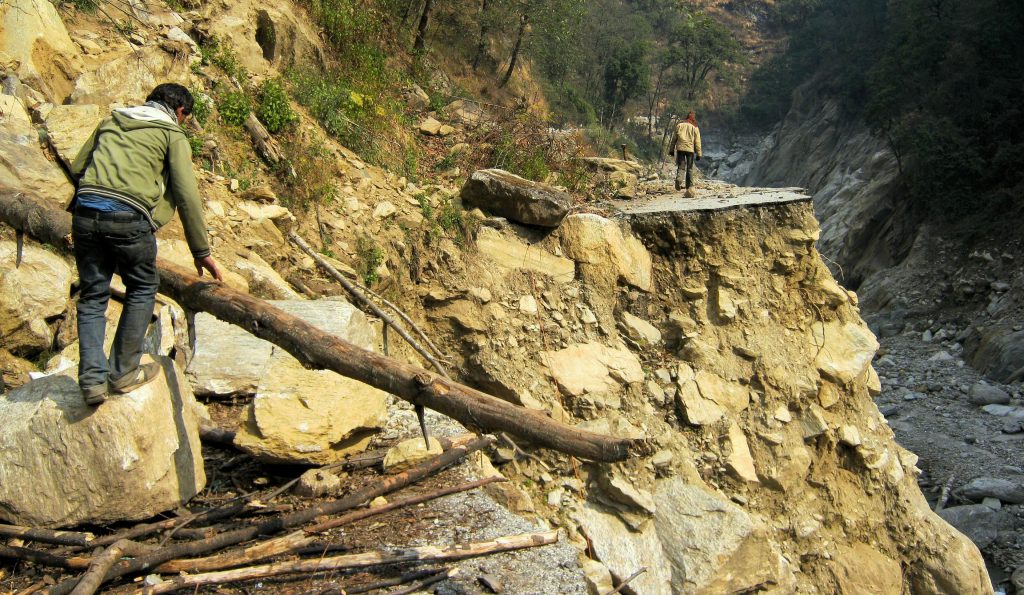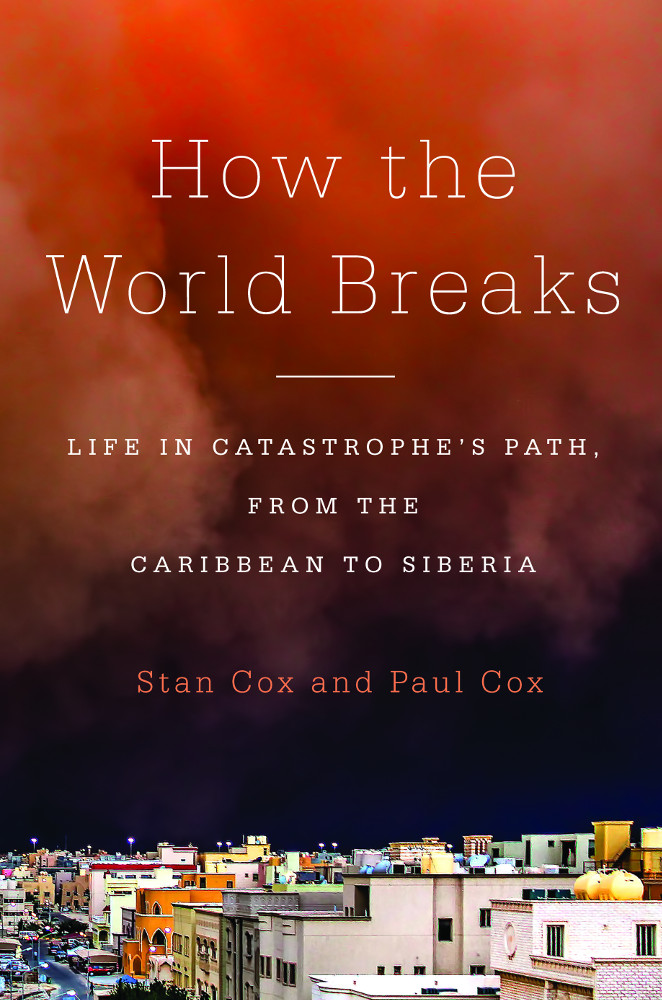Natural Disasters Are Less Natural Than You Think

Excerpted from How the World Breaks: Life in Catastrophe’s Path, From the Caribbean to Siberia by Paul Cox and Stan Cox. The New Press, 2016. All rights reserved.
“In the most general sense of progressive thought, the Enlightenment has always aimed at liberating men from fear and establishing their sovereignty. Yet the full enlightened Earth radiates disaster triumphant.”
—Max Horkheimer and Theodor Adorno, Dialectic of Enlightenment, 1972
There once were events called natural disasters. Unpredictable, blind, violent, they sprang from the Earth and taught us humility. Unlike military conflicts, factory fires, mine explosions, oil spills, or plane crashes, natural disasters left no responsible party to be fingered, so they tended to foster a we’re-all-in-this-together spirit of goodwill and a resolve to build back better and safer.
The natural disaster had a pretty good run, lasting a little more than two centuries. By most accounts, it emerged from the aftermath of the 1755 Lisbon earthquake/fire/tsunami, when Enlightenment scholars denounced the prevailing doctrine of divine punishment, denying that any God worthy of the name would inflict on humanity a disaster so horrific. A fissure opened in the modern mind between natural evil and moral evil, and the category of the indiscriminate, unfeeling, natural disaster was born.
Disasters began turning unnatural again in the 1970s, when researchers’ attention shifted away from physical hazards and toward the vulnerability of people and communities. In the words of the pioneering disaster anthropologists Anthony Oliver-Smith and Susanna Hoffman, “A disaster is made inevitable by the historically produced pattern of vulnerability, evidenced in the location, infrastructure, sociopolitical structure, production patterns, and ideology that characterizes a society,” and those conditions have far more influence on the scale and severity of the disaster than the force of the hazard itself.
Nature remains full of hazards, but only some of them wreak disaster. It is human-built structures, not the shaking ground, that kill when an earthquake strikes; people live, often out of desperation, in low-lying slums where flooding is a certainty; well-intentioned forest managers fuel bigger fires; evacuation systems fail; nuclear plants are built along risky coasts; and devastated communities either get help to survive and recover, or they don’t.
Despite all of that, people still talk and write about natural disasters, because everyone knows what one is. The words carry the weight of common sense, neatly defining calamities that appear to arise unbidden from the sea, ground, or sky. In practice, too, most attention and effort is still directed not at the social, political, and economic root causes but toward engineering protection against climatic and geological threats, rescuing victims, providing emergency relief, and rebuilding.
There’s another reason that the “natural disaster” label has long outlived its expiration date. It’s really about blame—deflecting it, dissipating it, or removing it from the equation completely. But unfortunately for the blameworthy, science is learning more every year about how human activity is contributing not only to natural-looking disasters but even to the fluxes of air, earth, and water that inflict the destruction. This didn’t start with greenhouse emissions, but it may end there. Climate disruption has collapsed the last walls between the human and the natural—and the storms are growing.
Merchants of Optimism
In 2014, the controversial political scientist Roger Pielke Jr. penned a typically contrarian piece for the data journalism site FiveThirtyEight, challenging the idea that storms were getting worse because of climate change—or even that they were getting worse at all:
When you read that the cost of disasters is increasing, it’s tempting to think that it must be because more storms are happening. They’re not. All the apocalyptic ‘climate porn’ in your Facebook feed is solely a function of perception. In reality, the numbers reflect more damage from catastrophes because the world is getting wealthier. We’re seeing ever-larger losses simply because we have more to lose—when an earthquake or flood occurs, more stuff gets damaged. . . .
There is some good news to be found in the ever-mounting toll of disaster losses. As countries become richer, they are better able to deal with disasters—meaning more people are protected and fewer lose their lives. Increased property losses, it turns out, are a price worth paying.
Climate scientists lined up to attack the piece for its highly selective use of data, and the fight got so ugly that FiveThirtyEight dropped Pielke as a contributor.
Pielke tends to get labeled a climate change denier by his critics, but he is really just an optimist. And his gospel of protection through wealth remains popular among fellow optimists. Certainly, things would be simpler if the world really could buy its way out of disaster. Carrying on with the business of capital accumulation, in the optimists’ view, could tip the balance of loss away from human lives toward the loss of humans’ stuff, which can be replaced. Disasters could be domesticated, soaked up by the larger economy, so we the people could all experience such events as something distant and manageable, canceled out on future balance sheets by the inevitable silver linings.
As an approach to protecting us all, the business-as-usual approach to disasters comes with three implicit conditions. First, to the extent that generating this insulating prosperity depends on burning a lot more carbon, Pielke implicitly asked us to ignore the connection between that new carbon dioxide in the atmosphere and the generation of more, bigger disasters. Second, the security-through-wealth strategy is predicated on increasing equality—that the rising tide will lift all boats and swamp none—even though a growing gap in economic power between the owning class and the rest of us is our reality, and the poorer you are, the greater the risk to your life and livelihood. Third, if the future really will bring escalating disaster costs in exchange for fewer deaths, it will become more and more necessary to ask who is going to pay those costs.
Disaster optimism is, we believe, what we will have to worry about when we don’t have to worry about climate change denial anymore. Pielke has moved on to other subjects of study, but neoliberal economists in the United States and other wealthy countries continue to argue that any storm, earthquake, or fire, even one of unprecedented ferocity, can be absorbed without long-term negative effects on the growth of the rich economies.
However, not all economists are convinced by models that forecast the full domestication of disaster. In the view of Nicholas Stern, lead author of the well-known 2007 Stern Review on the economics of climate change, all estimates of the damage that will result from a business-as-usual climate strategy are badly underestimated.
Disaster optimism is, we believe, what we will have to worry about when we don’t have to worry about climate change denial anymore.
One of the most obvious of many problems, Stern argues, is that the models almost always project the impacts of greenhouse warming against a background of uninterrupted economic growth. That assumption of growth is based entirely on circular reasoning: the argument that a decline in economic growth, regarded as the most undesirable outcome of climate change, can be avoided only if steady growth can be maintained indefinitely. (Then there’s the even more fundamental fact that unending growth would require infinite physical resources and is clearly impossible.) Stern believes that even before resources are exhausted, growth will falter badly. He recommends that economic modelers “embrace a real possibility of creating an environment so hostile that physical, social, and organizational capital are destroyed, production processes are radically disrupted, future generations will be much poorer, and hundreds of millions will have to move.”
Whatever the future impact of climate change on the rich world, the already overstressed global South will be devastated by the expected increase in the number and intensity of disasters. To hundreds of millions around the world today, the armchair debate among economists over how to handle climate chaos is about as relevant as this weekend’s weather forecast for Palm Beach. Progress may have been made in reducing mortality from disasters, and annual damages have so far been held to an acceptable fraction of gross domestic product, but neither fact will bring any solace to the typhoon survivor who’s already wading through sewage-laced floodwaters, or a family that has lost everything to a landslide, or has had to flee to shelter far from home, or has descended permanently into debt, or has been sucked into a black hole of poverty.
From Disaster to Resilience and Back
The economic impact of a hurricane or earthquake makes for good headlines, but not as many as are grabbed by the prime metric of catastrophe: the death toll. It is right and just that property losses take a back seat to loss of life. This tradition affirms that every life has high, and equal, value. But it falls short, and stands to fall even shorter, if we define a life only in the binary, as a death avoided. What is also lost is the share of life that has to be invested in repair. First, there has to be survival, which often means abandoning one’s home; then mutual aid; then reconstructing home, body, psyche, and community; then paying off the debt of lost livelihood incurred in the years of recovery. It’s difficult to calculate this sort of toll and even harder to quantify human misery, which is why survivors’ accounts are another tradition in the reporting of disaster. The headline gives the death toll, but tales from within the disaster complicate the binary of life and death.
Without such stories, another form of optimism may keep us too comfortable on our descent into a calamitous future: our faith in resilience. In the past decade and a half, resilience has come to be deployed everywhere and defined far too seldom. Its ring of familiarity (partly due to an older, not quite related usage in psychology) makes it sound like a self-evident virtue that has been around forever. In reality, it’s something quite a bit stranger.
The current shape of resilience can be seen in the United Nations’ Sendai Framework for Disaster Risk Reduction 2015-2030, the preeminent international action plan signed by 186 governments. This document employs the U.N. definition of resilience as “the ability of a system, community, or society exposed to hazards to resist, absorb, accommodate to, and recover from the effects of a hazard in a timely and efficient manner, including through the preservation and restoration of its essential basic structures and functions.”
As applied in the neoliberal governance of disaster, the resilience doctrine was initially based on a dubious borrowing of a singular definition of resilience that emerged from the study of ecosystems in the 1970s. In the current U.N. definition, we can still make out the language of ecology, as human resilience is depicted as mirroring the natural ability of a forest or wetland to return to balance after a disruption. But this new version of resilience is not an inherent property of systems, as it was in ecology; now it’s an aspiration. You no longer have to be a victim, experts are telling exposed and vulnerable communities. You can be a hero.
Meanwhile, the resilience doctrine’s utility for the policymaker lies in what it leaves out, the two factors that are unique to the world of the human: labor and political power. Political power gives those who wield it the ability to evacuate to the high ground of setting societal priorities, while others are left behind to be resilient, to do the hard and dirty work of survival.
Labor in the disasterscape is at least a matter of survival, and at most a matter of universal humanity—and in the midst of that desperate struggle, a fair wage is the last thing on anyone’s mind. So if we’re asking vulnerable communities to be the source of resilience, this is what we’re asking of them: to work constantly, and without compensation, toward the capacity to absorb shocks and changes so that the rest of us don’t have to worry about those shocks and changes, and we can keep generating more of them. It’s the expendability of their time and enjoyment of life that makes capitalism resilient.
This link between fragility and strength may seem paradoxical, but it’s exactly how resilience works—what theorists call its modularity. When individual “modules” are toughened up, the system as a whole becomes insensitive to shocks, setting itself up for collapse when the big one hits. So for the system to be resilient, modules have to be breakable. This principle, which has been called the “conservation of fragility,” is a reminder that resilience can be described only within a specific place and time. Resilient parts don’t add up to a resilient whole.
Although the word “resilience” is at times used interchangeably with “sustainability,” we see that it’s very different. A sustainable household makes a city more sustainable, which makes a nation more sustainable, which makes our species’ whole tenure on Earth more sustainable. Resilience isn’t like that. A society can be highly resilient for a century but destroy its resource base in the process, ruining its next century. A community can bounce back from a catastrophe by virtue of outside support—say, from federal flood insurance—but enough such events can sink the insurance program. Conversely, a vulnerable community’s destruction can create a buffer zone, or it can prompt more widespread action to confront the hazard. It’s necessary to examine resilience at a specific scale, but, in a world where cross-scale subsidies and feedbacks are what really matter, it’s also insufficient.
Disaster theorists are trying very hard to figure out what is sufficient. The messiness and internal contradictions of resilience make it a dubious metric (if it even is a metric), and it tells us nothing about what is good, bad, necessary, or just. Maybe, like “natural disasters,” it isn’t even about ecology or nature at all; maybe it’s just an attempt to explain in retrospect how we’ve chosen to organize the unnatural world we now inhabit.
The powerful have also chosen to organize how that world breaks: not in one great collapse, but in millions of local cataclysms small and large, disasters that protect and power global capitalism. Of the people who are spending their lives patching over these tears in the fabric of the world, we think it’s an injustice to argue over whether they are heroes or victims. They are both, and assigning one identity over the other is a very deliberate act of reductive representation. Heroes don’t blame others when calamity strikes; victims don’t manage to find a way out of their vulnerability. Those who suffer unnatural disasters do both, as required, and that is the way the world will heal.

































